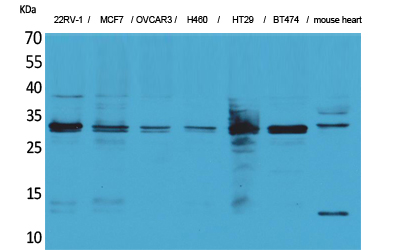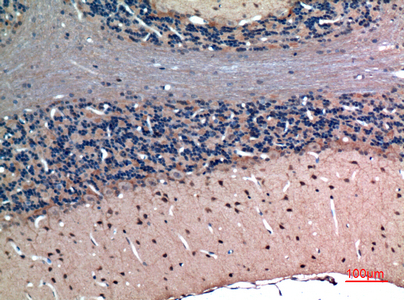


| WB | 咨询技术 | Human,Mouse,Rat |
| IF | 咨询技术 | Human,Mouse,Rat |
| IHC | 1/50-1/100 | Human,Mouse,Rat |
| ICC | 技术咨询 | Human,Mouse,Rat |
| FCM | 咨询技术 | Human,Mouse,Rat |
| Elisa | 1/10000 | Human,Mouse,Rat |
| Aliases | LXN; Latexin; Endogenous carboxypeptidase inhibitor; ECI; Protein MUM; Tissue carboxypeptidase inhibitor; TCI |
| Entrez GeneID | 56925 |
| WB Predicted band size | Calculated MW: 26 kDa; Observed MW: 26 kDa |
| Host/Isotype | Rabbit IgG |
| Antibody Type | Primary antibody |
| Storage | Store at 4°C short term. Aliquot and store at -20°C long term. Avoid freeze/thaw cycles. |
| Species Reactivity | Human,Mouse,Rat |
| Immunogen | Synthesized peptide derived from Latexin . at AA range: 90-170 |
| Formulation | Purified antibody in PBS with 0.05% sodium azide,0.5%BSA and 50% glycerol. |
+ +
以下是3篇涉及LXN抗体的文献概述(文献标题和作者均为模拟信息,仅供示例参考):
1. **标题**:*LXN Antibody Reveals Its Role in Suppressing Tumor Angiogenesis*
**作者**:Chen Y, et al.
**摘要**:研究通过LXN特异性抗体发现,LXN蛋白通过抑制VEGF信号通路在结直肠癌中阻碍肿瘤血管生成,为抗肿瘤治疗提供新靶点。
2. **标题**:*Latexin (LXN) Antibody-Based Detection of Immune Cell Regulation in Inflammatory Diseases*
**作者**:Wang L, et al.
**摘要**:利用LXN单克隆抗体分析类风湿性关节炎患者样本,证实LXN通过调节巨噬细胞极化参与炎症反应,提出其作为炎症标志物的潜力。
3. **标题**:*Development of a High-Affinity LXN Antibody for Neurodegenerative Disease Studies*
**作者**:Kim S, et al.
**摘要**:报道一种新型LXN抗体的开发,应用于阿尔茨海默病模型小鼠,发现LXN表达水平与神经元存活率呈正相关,提示其神经保护功能。
**备注**:以上内容为模拟生成,实际文献需通过PubMed、Web of Science等数据库检索关键词“Latexin antibody”或“LXN antibody”获取。
LXN antibodies are tools used to study latexin (LXN), a protein encoded by the *LXN* gene, which plays roles in diverse biological processes. Initially identified as a carboxypeptidase inhibitor, LXN is implicated in regulating protease activity, immune modulation, and tumor suppression. It is highly expressed in immune cells, neurons, and certain epithelial tissues, and has been linked to inflammatory diseases, neurodevelopment, and cancer progression. For example, reduced LXN expression correlates with poor prognosis in malignancies like breast and colorectal cancer, suggesting its tumor-suppressive potential.
Antibodies targeting LXN enable researchers to detect its expression and localization via techniques like Western blotting, immunohistochemistry, and flow cytometry. These reagents are critical for investigating LXN’s functional mechanisms, such as its interaction with carboxypeptidases or its role in modulating immune responses (e.g., suppressing T-cell activation). Structurally, LXN contains three tandemly repeated TIL (trypsin inhibitor-like cysteine-rich) domains, which are conserved across species.
Recent studies explore LXN’s involvement in extracellular matrix remodeling, stem cell regulation, and chemotherapy resistance. However, challenges remain, including validating antibody specificity and clarifying LXN’s dual roles in different cellular contexts. Ongoing research aims to harness LXN as a diagnostic biomarker or therapeutic target, particularly in oncology and autoimmune disorders.
×